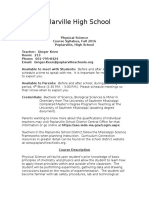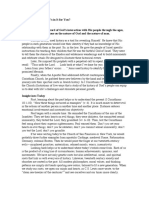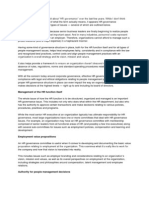Managing in A Dynamic Environment Learning Objectives: Learning Objective 1: Define Managers and Management
Managing in A Dynamic Environment Learning Objectives: Learning Objective 1: Define Managers and Management
Uploaded by
mahmialter2948Copyright:
Available Formats
Managing in A Dynamic Environment Learning Objectives: Learning Objective 1: Define Managers and Management
Managing in A Dynamic Environment Learning Objectives: Learning Objective 1: Define Managers and Management
Uploaded by
mahmialter2948Original Description:
Original Title
Copyright
Available Formats
Share this document
Did you find this document useful?
Is this content inappropriate?
Copyright:
Available Formats
Managing in A Dynamic Environment Learning Objectives: Learning Objective 1: Define Managers and Management
Managing in A Dynamic Environment Learning Objectives: Learning Objective 1: Define Managers and Management
Uploaded by
mahmialter2948Copyright:
Available Formats
Ch.
1: Managing in a Dynamic Environment
1-1
CHAPTER 1 MANAGING IN A DYNAMIC ENVIRONMENT LEARNING OBJECTIVES 1. Define managers and management. 2. Explain what managers do. 3. Describe the competencies used in managerial work and assess your current competency levels. Learning Objective 1: Define Managers and Management. A. Managerial Competencies 1. What are Managerial Competencies? a. sets of knowledge, skills, behaviors, and attitudes that a person needs to be effective in a wide range of positions and various types of organizations 2. Six Key Managerial Competencies (Table 1.1 in text) a. communication d. strategic action b. planning and administration e. global awareness c. teamwork f. self-management B. Organizations and Managers 1. What is an Organization? a. a coordinated group of people who function to achieve a particular goal 2. What is a Manager? a. a person who plans, organizes, leads, and controls the allocation of human, material, financial, and information resources in pursuit of the organization's goals 3. What is Management? a. group of individuals holding managerial positions within an organization b. tasks and activities that managers do: planning, organizing, leading, and controlling C. Types of Managers 1. Functional Managers a. supervise employees with expertise in a single area e.g., accounting, human resources, sales, finance, marketing, or production
1-2
Ch. 1: Managing in a Dynamic Environment
2. General Managers a. responsible for the operations more complex units e.g., a company or a division b. usually oversee functional managers c. Learning Objective 2: Explain What Managers Do. A. General Managerial Functions 1. Planning a. determining organizational goals and means to reach them. Reasons to plan: to establish an overall direction for the organizations future; to identify and commit resources to achieving its goals; to decide which tasks must be done to reach those goals. 2. Organizing a. deciding where decisions will be made, who will perform what jobs and tasks, and who will report to whom in the company structure enables them to carry out management's plans and meet overall objectives 3. Leading a. getting others to perform the necessary tasks by motivating them to achieve the organizations goals 4. Controlling a. consciously monitoring performance and taking corrective action B. Levels of Management 1. First-Line Managers a. e.g., sales managers, section heads, production supervisors, or team leaders b. directly responsible for the production of goods or services c. spend most of their time with people they supervise and other firstline managers d. need strong technical skills 2. Middle Managers a. department heads, plant managers, or directors of finance, human resources, etc. b. responsible for setting objectives consistent with top managements goals and translating them into specific goals and plans for first-line managers to implement
Ch. 1: Managing in a Dynamic Environment
1-3
c. spend most of their time enabling first-line managers and nonmanagerial employees to work effectively d. developing subordinates is essential to success 3. Top Managers a. e.g., CEO or president b. responsible for the overall direction of an organization c. spend most of their time (more than 75 percent) planning and leading Learning Objective 3: Describe the Competencies Used in Managerial Work and Assess Your Current Competency Levels.
A. What It Takes to Be a Great Manager 1. Communication Competency a. effective transfer and exchange of information that leads to understanding between yourself and others b. includes informal communication formal communication negotiation c. involves speaking, writing, listening, observing body language, picking up on subtle cues used to modify meaning soliciting and accepting feedback building a social network of contacts 2. Planning and Administration Competency a. deciding what tasks need to be done deciding how they can be done allocating resources to enable them to be done monitoring progress to ensure that they are done b. involves information gathering, analysis and problem solving planning and organizing projects time management budgeting and financial management 3. Teamwork Competency a. accomplishing tasks through small groups of people who are collectively responsible whose job requires coordination b. achieved by designing teams properly
1-4
Ch. 1: Managing in a Dynamic Environment
creating a supportive team environment managing team dynamics appropriately 4. Strategic Action Competency a. understanding the overall mission and values of the organization and ensuring that employees actions match with them understanding the industry understanding the organization taking strategic actions 5. Global Awareness Competency a. carrying out an organizations managerial work by drawing on the human, financial, information, and material resources from multiple countries and serving markets that span multiple cultures b. includes cultural knowledge and understanding cultural openness and sensitivity Self-Management Competency a. taking responsibility for your life at work and beyond b. involves integrity and ethical conduct personal drive and resilience balancing work/life issues self-awareness and development
You might also like
- Narrative CV Guide Oxford June 2023 0Document9 pagesNarrative CV Guide Oxford June 2023 0imspiresNo ratings yet
- Quality Control in The Retail Pharmaceutical Practice (New)Document16 pagesQuality Control in The Retail Pharmaceutical Practice (New)Emad Ghoneim100% (1)
- Benchmark - Organizational Design, Structure, and Change PresentationDocument12 pagesBenchmark - Organizational Design, Structure, and Change PresentationVikram . PanchalNo ratings yet
- Competency-Based HR ManagementDocument53 pagesCompetency-Based HR ManagementYodhia Antariksa100% (9)
- PoM RevisionDocument38 pagesPoM RevisionGeraldwerreNo ratings yet
- Organization and Management: LESSON 1: Evolution of Management TheoriesDocument16 pagesOrganization and Management: LESSON 1: Evolution of Management TheoriesMs. ArceñoNo ratings yet
- A. Multiple Choice - Write The Letter of Your Answer (10 PTS)Document3 pagesA. Multiple Choice - Write The Letter of Your Answer (10 PTS)Mikee TanquecoNo ratings yet
- Chapter IDocument6 pagesChapter IZandro Umangay IcoNo ratings yet
- Management in Profit-Seeking and Not-For-Profit Organizations Large BusinessesDocument4 pagesManagement in Profit-Seeking and Not-For-Profit Organizations Large BusinessesВалентина АпостоловаNo ratings yet
- President of An OrganizationDocument6 pagesPresident of An OrganizationJose CabalumNo ratings yet
- Chapter - Two The Development of Management Thoughts / Theories Value of TheoryDocument11 pagesChapter - Two The Development of Management Thoughts / Theories Value of Theoryይርዳው ሲሳይ ወርቀልዑልNo ratings yet
- What Is Organization DevelopmentDocument11 pagesWhat Is Organization Developmenthedyaguila100% (2)
- TP Leadership and Management 2015 A Final Copy1Document92 pagesTP Leadership and Management 2015 A Final Copy1gladz25No ratings yet
- What Is Nonprofit Organization 1Document11 pagesWhat Is Nonprofit Organization 1Arati PatilNo ratings yet
- Chapter 5 OrganizationDocument12 pagesChapter 5 OrganizationAbdul Kadir ArsiwalaNo ratings yet
- Lesson 1 1.1 ManagementDocument15 pagesLesson 1 1.1 ManagementWilliam EstacioNo ratings yet
- Kelsey Clark 3 HR Frame WorksheetDocument4 pagesKelsey Clark 3 HR Frame Worksheetapi-538653350No ratings yet
- AQUINO, Maria Gabriela 3LM1 - Discussion Activity 1Document4 pagesAQUINO, Maria Gabriela 3LM1 - Discussion Activity 1Ella AquinoNo ratings yet
- Evalution of Management ThoughtDocument16 pagesEvalution of Management ThoughtShweta SharmaNo ratings yet
- 1 What Management Organization and Technology Factors Were Behind TheDocument1 page1 What Management Organization and Technology Factors Were Behind TheAmit PandeyNo ratings yet
- 8-IJBGM-Improving Maintenance Strategy FinalDocument24 pages8-IJBGM-Improving Maintenance Strategy Finaliaset123No ratings yet
- Human Resource Mba 4th SemDocument4 pagesHuman Resource Mba 4th SemSahil SethiNo ratings yet
- General Manager - Finance & Accounts: Job Description & Application FormDocument3 pagesGeneral Manager - Finance & Accounts: Job Description & Application FormBhagwatiprasad MathurNo ratings yet
- Boundary Permeability and Online-Offline Hybrid Organization A Case Study of Suning, ChinaDocument13 pagesBoundary Permeability and Online-Offline Hybrid Organization A Case Study of Suning, ChinaAANo ratings yet
- Methodology of Environmental Management System Process ModellingDocument11 pagesMethodology of Environmental Management System Process ModellingKomalNo ratings yet
- Project Manager Competence: Putting The PMBOK To WorkDocument7 pagesProject Manager Competence: Putting The PMBOK To WorkAnthony ChandraNo ratings yet
- Project Management For Construction - Organization and Use of Project InformationDocument16 pagesProject Management For Construction - Organization and Use of Project InformationFarid MorganNo ratings yet
- Organization Study GuidelinesDocument4 pagesOrganization Study GuidelinesbluespringsNo ratings yet
- Physical Science SyllabusDocument4 pagesPhysical Science Syllabusapi-325499687No ratings yet
- Mission of TcsDocument23 pagesMission of TcsCHIRAG JAIN 1823614No ratings yet
- Chapter 1 - Introduction: Why Do We Study History?Document2 pagesChapter 1 - Introduction: Why Do We Study History?dfefewfNo ratings yet
- International Journal of Business and Management Invention (IJBMI)Document13 pagesInternational Journal of Business and Management Invention (IJBMI)inventionjournalsNo ratings yet
- Compliance Officer AssuranceDocument8 pagesCompliance Officer AssuranceHer HuwNo ratings yet
- TQM Midterm ReviewerDocument8 pagesTQM Midterm Reviewerchizz popcornnNo ratings yet
- Church History: What's in It For You?: You Test The Lord Don't You GrumbleDocument5 pagesChurch History: What's in It For You?: You Test The Lord Don't You GrumbleFelix TamolangNo ratings yet
- Managing in Turbulent Times: True/False QuestionsDocument30 pagesManaging in Turbulent Times: True/False QuestionsGiang NgânNo ratings yet
- Management of The HR Function ItselfDocument2 pagesManagement of The HR Function Itselfshradha_chhapol5356100% (1)
- What Is Strat - ManDocument6 pagesWhat Is Strat - ManJohn Michael Antonio CuaNo ratings yet
- Accounting, Organizing, and Economizing - Miller - PowerDocument51 pagesAccounting, Organizing, and Economizing - Miller - PowerJosé Carlos de SouzaNo ratings yet
- Organizational Identity and Its Implication On Organization DevelopmentDocument8 pagesOrganizational Identity and Its Implication On Organization Developmentalanz123No ratings yet
- Meaning and Definition of Human Resources ManagementDocument22 pagesMeaning and Definition of Human Resources ManagementAaron HarrisNo ratings yet
- 1136 Sayantan ChoudhuryDocument5 pages1136 Sayantan ChoudhuryStan leeNo ratings yet
- CE 413 - Lecture Notes (Outline)Document5 pagesCE 413 - Lecture Notes (Outline)Zennielle RayponNo ratings yet
- New Trends in Organization Design: Commentary Open AccessDocument2 pagesNew Trends in Organization Design: Commentary Open AccessBambang TrimargunadiNo ratings yet
- Staff and Line - WikipediaDocument14 pagesStaff and Line - WikipediaCristine Dela CruzNo ratings yet
- Week 7 - Physical ScienceDocument6 pagesWeek 7 - Physical ScienceMhay EvangelistaNo ratings yet
- Unit-1 Management Is A Process of Planning, Decision Making, Organizing, LeadingDocument53 pagesUnit-1 Management Is A Process of Planning, Decision Making, Organizing, LeadingVigneshNo ratings yet
- Organization Development. Then, Now, and TomorrowDocument11 pagesOrganization Development. Then, Now, and TomorrowMiguel HRNo ratings yet
- Revision Notes - Management (HSSC)Document7 pagesRevision Notes - Management (HSSC)unwrittengirlNo ratings yet
- Chapter 1 Summary: The Definition of ManagementDocument9 pagesChapter 1 Summary: The Definition of ManagementMahmood Mohammed TahaNo ratings yet
- Management and Behavioral ProcessDocument164 pagesManagement and Behavioral ProcessRaghavendra Kaladi0% (1)
- Ambidextrous OrganizationDocument6 pagesAmbidextrous OrganizationReeya MehtaNo ratings yet
- Human Resource ManagementDocument23 pagesHuman Resource ManagementShruti TrikhaNo ratings yet
- Designing Organization StructuersDocument8 pagesDesigning Organization Structuerstulasinad123No ratings yet
- Management by Objective MBODocument2 pagesManagement by Objective MBOsasahitoNo ratings yet
- ORGANIZATIONS Are Viewed As Established Social Systems Designed To Carry Out Specific ObjectiveDocument6 pagesORGANIZATIONS Are Viewed As Established Social Systems Designed To Carry Out Specific ObjectiveReiche GomezNo ratings yet
- ICWA:: Foundation Paper 1: Organization & Management Fundamentals (One Paper: Three Hours - 100 Marks) Objective - .Document9 pagesICWA:: Foundation Paper 1: Organization & Management Fundamentals (One Paper: Three Hours - 100 Marks) Objective - .Akhil ChowdaryNo ratings yet
- Type of Sales Organization E28093 Line Sales OrganizationDocument6 pagesType of Sales Organization E28093 Line Sales OrganizationramNo ratings yet
- Construction Material Wastage Minimization and ManagementDocument4 pagesConstruction Material Wastage Minimization and ManagementMohamed WayrahNo ratings yet
- Adr Term PaperDocument26 pagesAdr Term PaperMay Angelica TenezaNo ratings yet
- BBC Learning English 6 Minute English A History of The World in 100 ObjectsDocument5 pagesBBC Learning English 6 Minute English A History of The World in 100 ObjectsAnonymous LkH6F2No ratings yet
- Research Paper: Total Quality ManagementDocument4 pagesResearch Paper: Total Quality ManagementSandeepSureshNo ratings yet
- Pareto Analysis of Total Quality ManagementDocument18 pagesPareto Analysis of Total Quality ManagementankitatiwarigNo ratings yet
- StaffingDocument24 pagesStaffingAzmi RahmanNo ratings yet
- L-DIP Final PaperDocument28 pagesL-DIP Final Paperapi-708993124No ratings yet
- A Study of Employee Engagement in The Canadian WorkplaceDocument2 pagesA Study of Employee Engagement in The Canadian Workplacealsaeed100No ratings yet
- Cover Letter For Assistant Professor Job FresherDocument6 pagesCover Letter For Assistant Professor Job Fresherafllwwtjo100% (1)
- Introducing The EFQM Model (Public)Document18 pagesIntroducing The EFQM Model (Public)WSMNo ratings yet
- Referee Report: 1. Personal DetailsDocument3 pagesReferee Report: 1. Personal Detailsintan laksmitaNo ratings yet
- Tapedzanyika Spiwe Quality Assignment ChitunhaDocument7 pagesTapedzanyika Spiwe Quality Assignment ChitunhaNIXON MOYONo ratings yet
- CH 10 Lesson 1Document9 pagesCH 10 Lesson 1api-262327064No ratings yet
- CSS Hawaii Final Report For Redaction Redacted FinalDocument570 pagesCSS Hawaii Final Report For Redaction Redacted FinalHonolulu Star-AdvertiserNo ratings yet
- Branding On SteelmaxDocument46 pagesBranding On SteelmaxvishnudarshuNo ratings yet
- HRM L-5Document17 pagesHRM L-5Shah ShahriarNo ratings yet
- (OPA - 01) Question Paper Limited Departmental Competitive Examination - 2006 For The Post of Chargeman-Gr - Ii (T) & (NT)Document8 pages(OPA - 01) Question Paper Limited Departmental Competitive Examination - 2006 For The Post of Chargeman-Gr - Ii (T) & (NT)Rohit Choudhari100% (1)
- Lecture 2 - HRM and HRDDocument40 pagesLecture 2 - HRM and HRDIsmatullah ButtNo ratings yet
- ALKAN Health Science, Business & Technology College Health Education Credit Hrs-3Document24 pagesALKAN Health Science, Business & Technology College Health Education Credit Hrs-3Gizachew AsimareNo ratings yet
- JD - Data ArchitectDocument3 pagesJD - Data ArchitectmarkNo ratings yet
- The Political Perception of Youth: Where Are We Heading To?Document6 pagesThe Political Perception of Youth: Where Are We Heading To?IOSRjournalNo ratings yet
- JD - Infra Project Manager (PMPM10)Document3 pagesJD - Infra Project Manager (PMPM10)rainmanlinuxNo ratings yet
- Thylefors & Persson 2014Document16 pagesThylefors & Persson 2014jpjdejager95No ratings yet
- Employability SkillsDocument4 pagesEmployability SkillsakshithNo ratings yet
- Leadership in OrganizationsDocument20 pagesLeadership in Organizationscol_gopikrishna100% (1)
- Chapter 1 Wps OfficeDocument19 pagesChapter 1 Wps OfficeYashas KumarNo ratings yet
- 1894 Course+outlineDocument6 pages1894 Course+outlineproftechitspecialistNo ratings yet
- Introduction To Talent Management PPT - 01Document14 pagesIntroduction To Talent Management PPT - 01Ajith KumarNo ratings yet
- CAGR Connect Issue IVDocument7 pagesCAGR Connect Issue IVbabif67308No ratings yet
- Research Format For Quantitative ResearchDocument45 pagesResearch Format For Quantitative Researchjuhanisahjamiel6No ratings yet
























































































